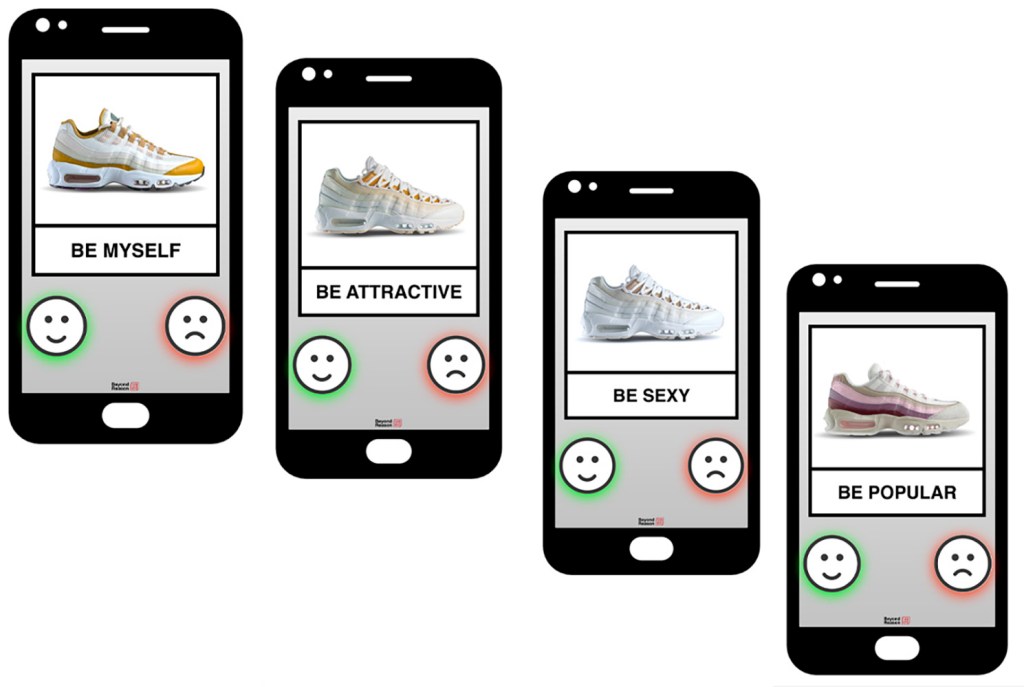Fashion and beauty firms depend so much on aesthetic appreciation for their products that more are likely in future to experiment with neuroaesthetic research methods, which unlock and interpret subconscious brain signals.
So argues Olivier Tjon, cofounder of neuromarketing consultancy Beyond Reason, which has already done such work for a small clutch of maverick companies. The Belgian firm collaborated with neuroscientists to develop implicit research methods to identify the immaterial factors in purchasing decisions and product preferences.
For an unnamed sporting goods firm aiming to extend its product range into everyday, lifestyle footwear, Beyond Reason delved into perceptions of what would be considered a “daily shoe rather than something for sport.”
“It had to do with the design and shape of the shoe, as well as materials, and colors,” Tjon said in an interview.
For research on various visual cues, test participants view hundreds of images on a phone screen and have milliseconds to indicate if it’s attractive or not, or described correctly.
The sporting goods firm supplied this information about specific aesthetic attributes to its designers, which yielded a hybrid model that immediately generated strong commercial traction, according to Tjon.
Likewise, for an unnamed beauty firm, Beyond Reason conducted neuroaesthetic research around the pleasing popping noise a lipstick tube should make when it is opened, as sound evokes certain associations deep within the brain. Tubes with the custom-calibrated sound have yet to reach shelves.
Tjon said he explains to potential clients that neuroaesthetics is “an experiment, not a fully established methodology.”
Yet it holds enough promise that this science-based metric is likely to be more widely embraced in future as an additional tool beyond “creative talent and gut feeling,” he predicted.
Tjon drew a parallel to early X-ray images, which he recently viewed at the Sorbonne’s museum in Paris. “To our eyes now, they look primitive. But even then, in their primitive, immature form, these X-rays outperformed what the eyes of a doctor could see by far, and I think we’re in the same situation.
“Even in its rudimentary form, [neuroaesthetic research] tells you things that cannot be measured without it,” he explained.
For its neuroaesthetic research, Beyond Reason, working with experts at Harvard, Washington and Virginia universities, developed techniques to measure implicit, subconscious associations in the brain.
Data compiled from Beyond Reason research and expressed as simple survey results suggest that:
- 72 percent of travelers prefer airports they find visually pleasing;
- 79 percent of shoppers spend more time in a store when they like the background music;
- 81 percent of commuters feel safer in a train with an interior design and color palette they find beautiful;
- 82 percent of women refuse to wear a perfume if they don’t like the smell, even if it’s a gift from a loved one.
Tjon allowed that at present, only “mavericks” are experimenting with neuroaesthetic insights. He cited reticence especially in the fashion and luxury sectors.
“The closer we get to the creative teams, the greater the resistance, which is understandable,” he said. “For a lot of creative people, it feels like their wings are being clipped.”
He said large beauty marketers tend to be more receptive, given the advent of biometrics — measuring brainwaves, pupil variations, galvanic skin responses and the like — to show the fragrance-mind connection. These have been used for several years, as has eye tracking to observe how consumers respond to products.
In Tjon’s estimation, neuroaesthetics will not eliminate design jobs, but will join other technological tools employed by creative industries.
He characterized neuroaesthetics as a form of predictive analytics that can reduce risk for fashion and beauty companies by anticipating the aesthetic and emotional response of a new product, packaging or ad campaign.
“There is nothing wrong with concentrating the creative talent in a zone that has a higher capacity to resonate within the consumer’s psyche,” Tjon argued.



